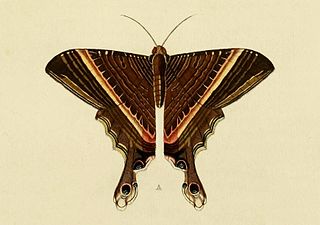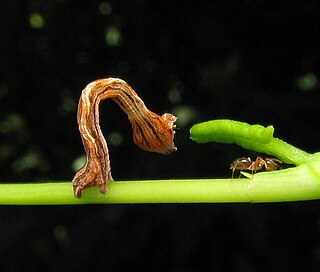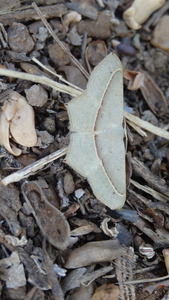
Moths are a group of insects that includes all members of the order Lepidoptera that are not butterflies. They were previously classified as suborder Heterocera, but the group is paraphyletic with respect to butterflies and neither subordinate taxon is used in modern classifications. Moths make up the vast majority of the order. There are approximately 160,000 species of moth, many of which have yet to be described. Most species of moth are nocturnal, although there are also crepuscular and diurnal species.

The Sphingidae are a family of moths commonly called sphinx moths, also colloquially known as hawk moths, with many of their caterpillars known as "hornworms"; it includes about 1,450 species. It is best represented in the tropics, but species are found in every region. They are moderate to large in size and are distinguished among moths for their agile and sustained flying ability, similar enough to that of hummingbirds as to be reliably mistaken for them. Their narrow wings and streamlined abdomens are adaptations for rapid flight. The family was named by French zoologist Pierre André Latreille in 1802.

The Tortricidae are a family of moths, commonly known as tortrix moths or leafroller moths, in the order Lepidoptera. This large family has over 11,000 species described, and is the sole member of the superfamily Tortricoidea, although the genus Heliocosma is sometimes placed within this superfamily. Many of these are economically important pests. Olethreutidae is a junior synonym. The typical resting posture is with the wings folded back, producing a rather rounded profile.

The name death's-head hawkmoth refers to any of three moth species of the genus Acherontia. The former species is found throughout Africa and in Europe, the latter two are Asian; most uses of the common name refer to the African species. These moths are easily distinguishable by the vaguely human skull-shaped pattern of markings on the thorax. They are large nocturnal moths with brown and yellow or orange coloring, and all three species are fairly similar in size, coloration and life cycle.

Saturniidae, members of which are commonly named the saturniids, is a family of Lepidoptera with an estimated 2,300 described species. The family contains some of the largest species of moths in the world. Notable members include the emperor moths, royal moths, and giant silk moths.

Vigna aconitifolia is a drought-resistant legume, commonly grown in arid and semi-arid regions of India. It is commonly called mat bean, moth bean, matki or dew bean. The pods, sprouts and protein-rich seeds of this crop are commonly consumed in India. Moth bean can be grown on many soil types, and can also act as a pasture legume.

The Lymantriinae are a subfamily of moths of the family Erebidae. The taxon was erected by George Hampson in 1893.

Gonimbrasia belina is a species of emperor moth which is native to the warmer parts of southern Africa. Its large edible caterpillar, known as the mopane worm, madora, amacimbi “pigeon moth” or masontja, feeds primarily but not exclusively on mopane tree leaves. Mopane worms are an important source of protein for many in the region. The species was first scientifically described by John O. Westwood in 1849.

Acherontia atropos, the Africandeath's-head hawkmoth, is the most widely recognized of three species within the genus Acherontia. It is most commonly identified by the vaguely skull-shaped pattern adorning the thorax, the characteristic from which its common and scientific names are derived. The species was first given its scientific name by Carl Linnaeus in his 1758 10th edition of Systema Naturae.

Sematuridae is a family of moths in the lepidopteran order that contains two subfamilies.

Traminda is a genus of moths in the family Geometridae described by Saalmüller in 1891.
William Warren was an English entomologist who specialised in Lepidoptera.

Timandrini is a tribe of geometer moths, with about 45 species in four genera. It was described by Stephens in 1850.

Traminda mundissima is a species of moth of the family Geometridae. It is found in Bahrain, Oman, the United Arab Emirates, Yemen, India, Thailand, New Calidonia and Australia, where it has been recorded from Western Australia, Queensland and New South Wales.

Traminda aventiaria, the cross-line wave moth, is a species of moth in the family Geometridae. The species was first described by Achille Guenée in 1858. It is found in the Indian subregion, Sri Lanka, to Hong Kong, Taiwan, New Guinea and Australia.














